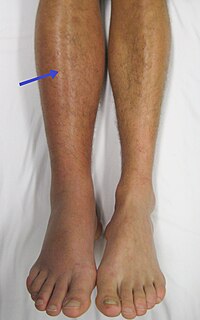
Photo from wikipedia
Anticoagulation is the first−line treatment in almost all patients with an acute episode of venous thromboembolism (VTE) [1]. Vena cava interruption by percutaneous inser‐ tion of an inferior vena cava… Click to show full abstract
Anticoagulation is the first−line treatment in almost all patients with an acute episode of venous thromboembolism (VTE) [1]. Vena cava interruption by percutaneous inser‐ tion of an inferior vena cava filter (IVCF) is not infrequently used in these patients, with the aim of reducing mortality rate due to pulmonary embolism (PE), the most feared com‐ plication of VTE [2]. Guidelines for IVCF proper use vary among countries and professional areas [1, 3–5]. The only commonly accepted indication for IVCF would be absolute contraindication to anticoagulation therapy, such as a major bleeding complication or a very high risk of bleeding at the time of VTE [1]. Nevertheless, this recommendation is solely based on historical practice, expert opinion and case series however not supported by prospective, randomized, controlled trials. To date, only two high quality studies, the PREPIC (Prevention du Risque d’ Embolie Pulmonaire par Interruption Cave) and the PREPIC 2, assessed the efficacy and safety of IVCF insertion in VTE patients, giving con‐ flicting results [6, 7]. In the PREPIC, IVCF reduced the risk of PE and increased that of deep vein thrombosis (DVT), with no effect on survival [6]. After a few years, in the PREPIC 2 trial, hospitalized patients with acute sympto‐ matic PE associated with lower−limb DVT and at least 1 criterion for severity, were assigned to retrievable inferior vena cava filter implantation plus anticoagulation, or to anti‐ coagulation alone with no filter implantation [7]. Over three months of follow−up, the use of a retrievable IVCF plus anticoagulation, compared with anticoagulation alone, did not reduce the risk of symptomatic recurrent PE. Hence, the efficacy of IVCF in this setting remains to be established. Furthermore, since in the PREPIC and PREPIC 2 studies patients were treated with anticoagulation, we do not have information from these studies on IVCF role in patients who cannot be anticoagulated. In a previous analysis of the RIETE (Registro Informatizado de la Enfermedad Trom‐ boembólica) database, including patients presenting with VTE and with a significant bleeding risk, IVCF insertion was associated with a lower risk of PE−related death and a higher risk of recurrent VTE compared with anticoagulant therapy [8]. In a subsequent analysis of the RIETE database, pub‐ lished in this issue of the Internal and Emergency Medicine Journal, Mellado et al. evaluated for the first time, the effect of IVCF insertion on mortality rate in VTE patients suffer‐ ing from a major bleeding event during anticoagulation [9]. Over a thirty−day follow−up period, the IVCF group had a significantly lower rate of all−cause death, and a similar amount of re−bleeding and PE recurrence compared with those patients who did not receive a filter. Of note, almost half the deaths (46%) in the study population were due to a recurrent bleeding (mostly in the gastrointestinal tract), with those who restarted anticoagulation earlier showing the highest rate of mortality. Interestingly, patients with IVCF resumed anticoagulation later than those without IVCF, given the potentially increased confidence of physicians in delaying anticoagulation with the presence of a PE−defend‐ ing tool, such as IVCF. Optimal timing of anticoagulation resumption (if any) after a major bleeding complication is not clear. Available evidence suggests resuming anticoagulants seven to fourteen days after a gastrointestinal bleeding and at least one month after an intracranial hemorrhage. However, the quality of evidence is quite low, and studies included patients antico‐ agulated mainly for atrial fibrillation [10, 11]. In the absence of anticoagulation therapy, patients with acute VTE have an unacceptably high rate of recurrence, especially within the first 30 days after the event. Therefore, withholding antico‐ agulation without using another method to reduce PE risk, may be very dangerous. As shown by Mellado et al., early reintroduction of anti‐ coagulation therapy seems to be associated with an increased * Francesco Dentali francesco.dentali@asst‐settelaghi.it
Journal Title: Internal and Emergency Medicine
Year Published: 2019
Link to full text (if available)
Share on Social Media: Sign Up to like & get
recommendations!